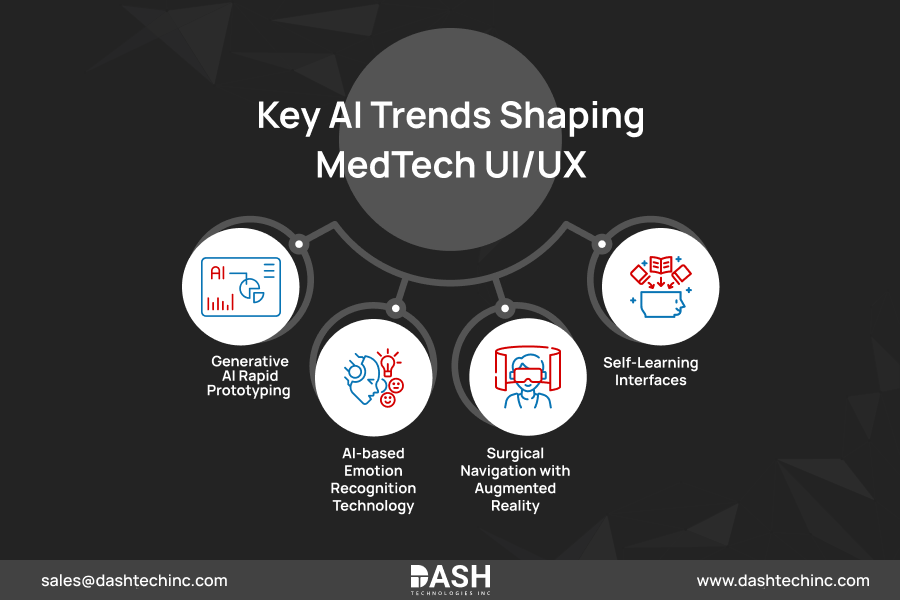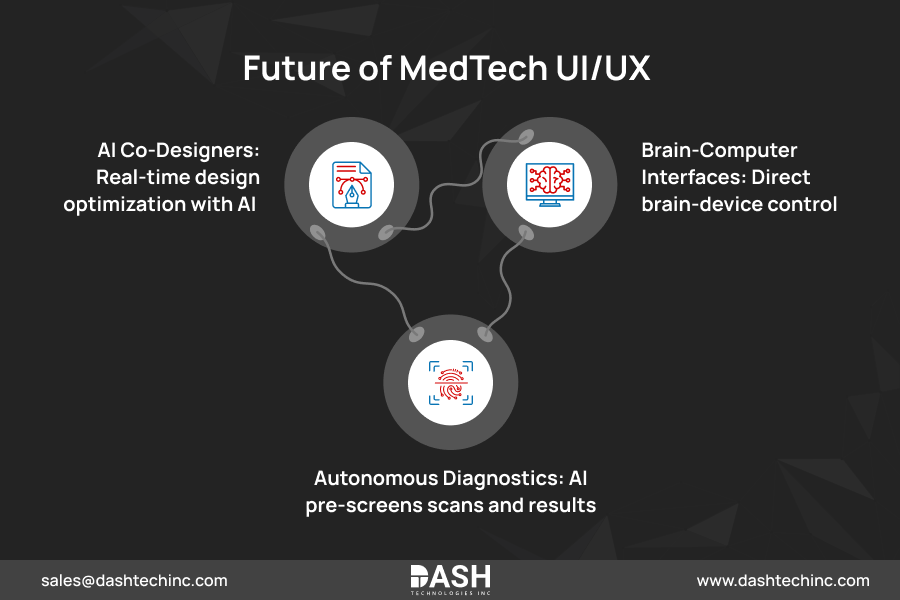The Future of UI/UX Design in MedTech: How AI is Leading the Way
The MedTech industry is undergoing a digital revolution, and the secret to this revolution lies in the integration of Artificial Intelligence (AI). UI/UX design in MedTech is emerging as a critical focus area, where AI is driving innovation and reshaping how users interact with digital healthcare solutions.
As healthcare UX design evolves, the emphasis is shifting toward creating intuitive, intelligent systems that improve both usability and outcomes. A strong healthcare user experience not only improves patient engagement but also reduces cognitive load for clinicians. At DASH, our belief is that AI is not just augmenting UI/UX design—it’s transforming it.
Let’s discuss how AI is transforming the face of MedTech interfaces that leads to improved patient care as well as seamless clinician user experience.
Importance of UI/UX Design in MedTech
Medical devices and healthcare software must meet usability standards to minimize errors and enhance efficiency. A poorly designed interface can lead to misdiagnosis, delayed uptake, and patient frustration. On the other hand, well-executed UI/UX in healthcare enables clearer communication of complex medical data, easing cognitive load for clinicians and improving patient engagement, and significantly enhancing overall healthcare user experience.
In MedTech, design is never merely about aesthetics —it’s about safety, precision, and effortless integration into clinical workflow. With the rise of AI, that vision is rapidly becoming a reality.
How AI Is Revolutionizing MedTech UI/UX Design
AI is revolutionizing UX design in healthcare, using the strengths of personalization, automation, and predictive analysis.
One of the biggest advancements is adaptive interfaces that acquire knowledge from user actions. For example, the most commonly used functions of a physician can be dynamically adjusted by an AI-powered EHR system in terms of menus, reducing clicks, saving time, and improving the overall healthcare user experience.
Another innovation is gesture and voice-controlled interfaces, particularly helpful in sterile environments like operating rooms. Surgeons can drive systems without touching them, avoiding contamination risks.
AI takes accessibility a step further by dynamically changing text size, contrast, and language settings. AI translation technology assures foreign language speakers that it avoids losing critical information in translation, enhancing the healthcare UX design..
MedTech UI/UX: AI-Driven Trends to Watch

Several advanced trends are shaping the future of healthcare UX design:
- Generative AI Rapid Prototyping: Tools such as Adobe Firefly and Figma AI enable designers to rapidly produce high-fidelity prototypes, reducing development cycle times.
- AI-based Emotion Recognition Technology: By detecting stress, confusion, or frustration in users, these tools adjust the interface in real time—improving usability and reducing error rates in UX design in healthcare.
- Surgical Navigation with Augmented Reality (AR): AR-based visuals that are AI-powered offer guided information and real-time information during procedures, such as precision and safety.
- Self-Learning Interfaces: These interfaces keep learning on their own through an amalgamation of user actions and eventually get more intuitive in the process.
Transform Your MedTech UI/UX with AI
Partner with DASH for cutting-edge design solutions that transform complex data into intuitive experiences.
Get In TouchChallenges and Ethical Issues
AI is a powerful force in MedTech design, but several key challenges must be addressed:
Data Privacy: Healthcare is one of the most sensitive industries, and AI systems require access to confidential patient data. This demands strict compliance with regulations such as HIPAA, GDPR, and other local data protection laws.
Failure to secure data not only risks breaches but can erode patient trust and invite heavy legal penalties. Ensuring robust encryption, secure data storage, and transparent consent processes are critical to maintaining privacy.
Algorithmic Bias: If AI models are trained on unrepresentative or biased datasets, they may inadvertently perpetuate disparities in healthcare delivery. This can lead to inequitable treatment recommendations and worsen existing gaps in care for underrepresented groups.
It is essential to use diverse, high-quality data and continuously audit algorithms to detect and mitigate bias, ensuring fairness and inclusivity in AI-driven solutions.
Over-Automation Risk: AI can streamline workflows and reduce human workload, but over-reliance on automation risks diminishing essential human oversight. Critical errors or unusual cases might be overlooked if systems lack proper checks and balances. Balancing automation with human judgment is necessary to safeguard patient safety and maintain accountability.
Transparency & Explainability: For AI to be trusted in clinical settings, its decision-making processes must be transparent and explainable to healthcare providers and patients. Black-box algorithms that cannot justify their outputs may face resistance, limiting adoption and effectiveness.
Innovation is, of course, a huge driver in creating trustworthy AI-driven MedTech solutions, but the need to meet that innovation with ethical accountability is paramount. This means not only addressing technical challenges but also fostering collaboration between technologists, clinicians, regulators, and patients to build AI that is safe, fair, and patient-centric.
Advancing MedTech UI/UX: AI and Beyond

The future of UI/UX design in MedTech and healthcare is exceptionally promising, driven by emerging technologies that are transforming how users interact with healthcare solutions. Key trends shaping this future include:
AI Co-Designers: AI tools are evolving beyond simple automation to actively collaborate with human designers. These intelligent assistants provide real-time optimization recommendations, streamline design workflows, and help create interfaces that are both user-friendly and clinically effective.
Brain-Computer Interfaces (BCIs): BCIs represent a groundbreaking frontier in MedTech, enabling direct communication between medical devices and the human brain. This technology holds incredible potential, particularly for patients with paralysis or neurodegenerative diseases, by restoring control and improving quality of life.
Autonomous Diagnostic UIs: AI-driven interfaces capable of pre-screening diagnostics such as imaging scans and lab results are set to revolutionize clinical workflows. By filtering and prioritizing data, these systems assist doctors in making faster, more accurate diagnoses while reducing cognitive overload.
Conclusion
AI is revolutionizing UI/UX design in MedTech by creating advanced, intelligent interfaces focused on dramatically improving clinical workflow efficiency. Features like customizable dashboards and voice-activated systems are just the beginning—AI’s potential to transform healthcare interactions is vast and continually expanding.
Are you leveraging AI to elevate the performance and usability of your MedTech products? At DASH, we specialize in AI-driven UI/UX solutions designed to enhance user experience, streamline workflows, and ultimately improve patient outcomes. Let’s work together to shape the future of healthcare technology.
About Dash

Dash Technologies Inc.
We’re technology experts with a passion for bringing concepts to life. By leveraging a unique, consultative process and an agile development approach, we translate business challenges into technology solutions Get in touch.









